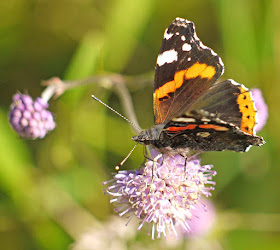Over the years I've acquired a small collection of Victorian and Edwardian natural history books. This one, without doubt, is my favourite.
The book is an account of the Gosse family's six weeks 'holiday' spent in the summer of 1854 on the Welsh coast at Tenby. Each chapter is written in the form of an extended letter home, to an un-named correspondent addressed as Dear E-, describing days spent exploring the caves and rock pools for marine life. Each chapter is dated, beginning on June 22nd.1854, with the last on August 17th.
It's written in an elegant, chatty style, brimful of enthusiasm, overflowing with natural curiosity and packed with natural history information and astute observations..
"PhilipHenryGosse,1855" by Maull & Polybank - Oxford Dictionary of National Biography. Licensed under Public Domain via Commons - https://commons.wikimedia.org/wiki/File:PhilipHenryGosse,1855.jpg#/media/File:PhilipHenryGosse,1855.jpg
It's Gosse's infectious enthusiasm that I found so charming about this book. From the beginning he's so clearly excited at the prospect of a summer holiday on the coast. Tenby was recommended to him 'as the prince of places for a naturalist' by fellow naturalist and Islington resident James Scott Bowerbank, a leading authority on the sponges that are found around Britain's coast.
Gosse begins by describing their seven hour journey on the Great Western Railway, marvelling at the 'rushing flight of the express-train, fifty miles an hour.....' and then describes the landscape from the train window as they leave London and steam through the countryside.
As they pass Stroud, a major centre for cloth dyeing at that time, he notices 'canals and rivulets tinged blue' with the industry's effluent. They pass the rocky cliffs of Chepstow, meander along tracks through the Wye valley until they can see the 'ever-widening [river] Severn', and pass the ruins of Neath abbey.
There are reminders that this was the height of the industrial revolution. Between Neath and Swansea they see yellow sulphurous smoke from copper smelting furnaces 'like a huge pall over the earth' that turns to sulphuric acid when it rains and then pass hills of 'coaly-looking material - copper slag,' before Worms Head in Carmarthen Bay hoves into view and they finally roll into their destination.
Then comes the excitement of arrival. "Narberth Road and Tenby" shouts the guard as he runs along the train; and up we jump, snatch up umbrellas, cloaks and carpet bags...."
Even then their journey isn't complete, because they need to catch the coach to the Coberg hotel in Tenby: ".... off we dashed, four in hand, four capital horses as ever drew a vehicle". he writes that on that summer day in June as they speed past "oaks and ashes over our heads" heads, past foxgloves, dog-roses, campions, honeysuckle.
And they arrive in time for tea, and for a visit to the seashore before bedtime.
"The tide was out, enabling us to reach St.Catherine's Island, and to peep through its perforated caves, and to take such a glance at its honeycombed rocks, and dark weedy basins, as was full of promise for tomorrow".
During this 'holiday' Gosse spent an enormous amount of time on the seashore, and then even more examining his finds, writing about them and illustrating them. The book's lithographs are exquisite. This (above) is the barrel jellyfish Rhizostoma pulmo, whose swimming he describes as being like 'the pulses of an enormous heart'.
Gosse was the son of a miniaturist portrait painter and seems to have inherited his father's eye for fine detail, an invaluable asset for a naturalist. His portrayal of transparent animals and their internal organs is exceptional, as in the case of this light bulb sea squirt (above).
He became a skilled microscopist, which allowed him to explore the minute planktonic stages of marine life: this (above) is the larva of a squat lobster and ....
... this is the bryozoan Bowerbankia, attached to part of a frond of the red seaweed Corallina officinalis. You can view a modern photograph of the same animal here.
Gosse's greatest passion for seashore animals was reserved for sea anemones - the anthozoa or 'flower-animals' - many of which are described in the text. The book frontispiece (above) features them, as does ....
... the final plate. There was a reason for this.....
Gosse, an astonishingly prolific author, was already working on his book about sea anemones, entitled Actinologica Britannica: a history of British Sea-Anemones and Corals that would be published in 1860. He needed help in collecting specimens that he could illustrate and this (above) is an advert, bound into the back of the book, which is an early example of what has now become known as 'citizen science' - enlisting the help of an informed public to collect information about the natural world for scientific purposes.
You can download an e-book copy of Actinologica Britannica , with its exquisite illustrations by clicking here. It's a classic of Victorian natural history publishing.
Gosse did more than anyone else to inform the public about the wonders of marine life, both in his books and also in the field. At the end of his book there is another advert, this time sounding out interest in a Marine Natural History Field Class that he planned to run.
Gosse's 'holiday' came during a period in his life when he was suffering from severe headaches and his trips to the coast were, in part, intended as a sea cure. If this book is any indication, his six weeks in Tenby were hardly a holiday. The amount of seashore natural history that he crammed in was prodigious and the adverts show that he had much more planned.
Philip Henry Gosse (1856) Tenby: A Sea-side Holiday. John Van Voorst, Paternoster Row, London can be downloaded in various e-book formats by clicking here
You can also read and download a superb, entertaining account by Margaret Davies of Victorian Naturalists in Tenby by clicking here. It was originally published in The Pembrokeshire historian : journal of the Pembrokeshire Local History Society in 1981.























